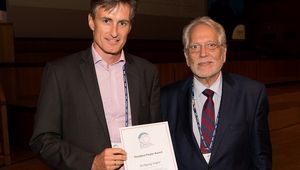Approximately 200,000 people in Austria are of short stature. The broad spectrum of etiologies and proportions associated with short stature is broad.

A new treatment is promising improved outcomes for children and adolescents diagnosed with achondroplasia, such as 12-year-old Livia from Linz. The Johannes Kepler University Linz is playing a key role in developing a new drug.
Achondroplasia, a hereditary disease, is marked by a very short stature with normal adult height being between 120 and 140 cm. The condition is also characterized by severe neural complications resulting from bone constriction in the spine as well as in back of the head, and bone deformities. Although achondroplasia has been documented for thousands of years, there is unfortunately no curative treatment for those affected.
A drug called Vosoritide (Voxzogo®) was recently approved to treat the growth disorders in small statured individuals diagnosed with achondroplasia and is being used at specialized centers, such as the Department of Pediatrics and Adolescent Medicine at the Kepler University Hospital, under the direction of board member Univ. Prof. Dr. Wolfgang Högler. The safe and effective medication is being administered daily by injection under the skin to accelerate growth.
Currently in Development, the New Drug Could Save Patients from 311 Injections A Year
An alternative, promising treatment has now been successfully tested, involving only one injection a week of the longer-acting alternative drug TransConCNP (navepegritide). The Department for Pediatrics and Adolescent Medicine is one of five European centers offering this new form of medication to its patients as part of a multicenter study.
One of the patients is Livia. Despite having the condition, the 12-year-old is very active and independent, and enjoys painting and swimming. She has been taking part in the study since April 2021 and is given the injection once a week.
Livia's mother remarked: "We are very thankful that Livia can take part in the study. She is constantly under the doctors’ supervision, which is also less of a psychological burden for us. Our daughter has become more self-confident and is beginning to accept herself the way she is. Each step forward brings us great joy. Livia started at a new school last year and she’s not only made friends, she’s singing in the school choir."
Prof. Wolfgang Högler is enthusiastic about the results: "The new treatment at the set dosage (phase 2 study) has resulted in a height increase of over 1 cm during the first year of treatment as compared to without the treatment. While this may not seem like much, if sustained over several years, we could see a good increase in height into adulthood, providing treatment is initiated at an early stage. We are also hoping for additional beneficial therapeutic effects, which can only be determined through long-term studies, namely, the widening of bony constrictions that occur during growth. These constrictions may result in neurological problems during adulthood. To this end, we need to observe the children into adulthood and then collect the corresponding data once they reach end-of-life height or adulthood. We still have a lot of work to do."
The study findings were recently published in the renowned scientific publication "Lancet Discovery (eClinicalMedicine)" and demonstrate the compound’s effectiveness and safeness. The JKU Linz has been significantly involved in developing this new drug. If approved for the market, this short-acting drug could save patients an annual total of 311 injections while maintaining similar effectiveness and safeness.
Click here, opens an external URL in a new window to read the paper in the publication “Lancet Discovery (eClinicalMedicine)”.
 Go to JKU Homepage
Go to JKU Homepage











